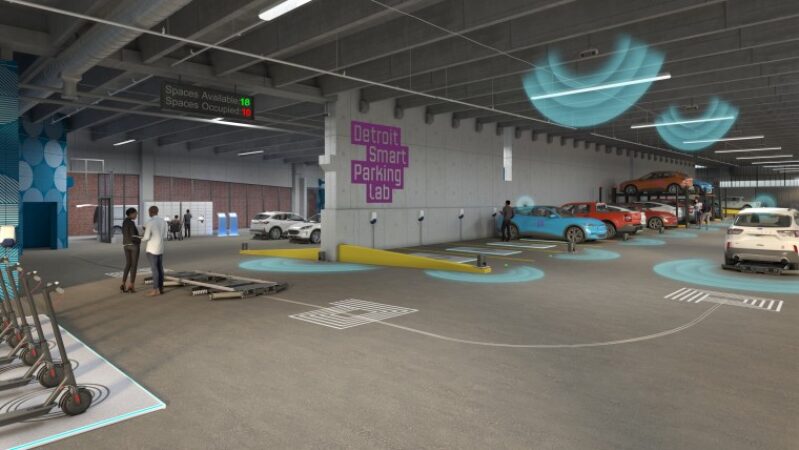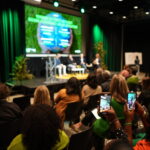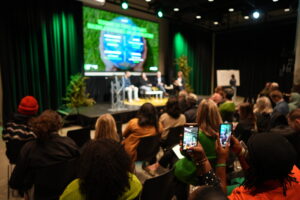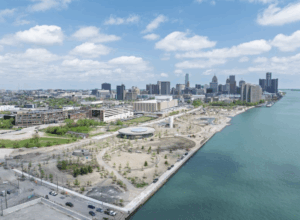Locating parking in an urban environment can account for as much as 30 percent of vehicle traffic and emissions. It can also account for big headaches. Who hasn’t experienced the aggravation of parking in the city?
Via a unique partnership born in Detroit, that’s about to change.
Imagine using an app to set a pre-determined location, arriving there, and simply stepping out of your car and going about your business while your vehicle automatically identifies its own parking spot in a nearby lot or parking garage, drives itself there, and parks. And when you are ready to move on, the same scenario occurs, effectively eliminating the frustration of parking altogether.
Enter the Detroit Smart Parking Lab.
Ford, Bosch, Bedrock, and the State of Michigan recently launched this first-of-its-kind real-world test site lab, allowing mobility and smart infrastructure innovators to test automated valet parking, automated parallel parking, EV charging technologies, and much more.
And it’s the only one of its kind in the country – fittingly in the Motor City.
The lab – opened last month to innovators and with a public unveiling November 10 – is strategically located at the Bedrock Assembly in Corktown where Ford is developing a mobility innovation district anchored by Michigan Central Station.
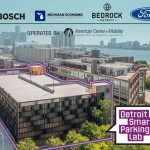
DETROIT SMART PARKING LAB
“We are excited and proud to have formed this collaboration, which brings together not just physical assets but our imaginations and our minds,” said Craig Stephens, Chief Engineer at Ford Motor Company. “It’s completely aligned with our bigger plan involving transportation and mobility innovation, sitting right near our Corktown Center, and to see it come to life with the support of the State is truly validating. It represents the commitment of all parties to create an environment for technology and mobility-related companies to thrive and grow in Michigan.”
The Parking Lab evolved from the traction built in August 2020 when Ford, Bedrock, and Bosch led an automated valet parking demonstration that allowed Ford Escape vehicles to drive and park themselves at Bedrock’s Assembly garage.
“We are always looking for ways to improve the downtown experience for community members, visitors, residents and future residents,” says Kate Gassparro, Bedrocks Urban Innovation & Strategy Director. “Bedrock has played at edges of this technology that drives mobility and transportation, and this initiative allows us to go much deeper now. We look forward to hosting pioneers in technology and mobility from around the world.”
And opening its doors to everyone from start-ups to entrepreneurs to leaders in tech development across the globe is certainly the vision.
The lab will serve as an accessible innovation and collaboration platform for all, says Kevin Mull, Connected Mobility Services, Bosch. The mission here is innovation – testing theories and growing opportunities – and we welcome all who are looking to do so.
In full support of this mission, the MEDC in partnership with the Office of Future Mobility and Electrification has established the Michigan Mobility Funding Program where organizations can secure funding to develop and test parking-inspired mobility solutions within and around the garage. “Our intention is to continue to strengthen the state’s economy while enhancing the transportation needs of our residents,” says Kathryn Snorrason, Managing Director of the Office of Future Mobility & Electrification. “We look to attract companies from around the world, and this platform opens the doors to finding long-term success here for those companies.”
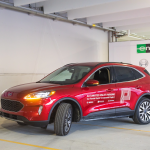
ENTERPRISE QTA TESTING
This cross-section of collaborators offers significant implications and learnings from many different perspectives. Says Mull, “Bedrock is prominent in deploying infrastructure in Detroit and enhancing the way people move about and efficiently utilize the environment. Layer in Ford and Bosch, and now we are at the intersection of infrastructure, mobility innovation, and technology. We can test transportation technology in this real-world setting and utilize the learnings for all sorts of things. Layer in the State of Michigan opening grants for the use of the lab and opportunities are seemingly endless.”
Regarding what this means for the residents, citizens, and patrons. Gassparro says,
Every trip downtown begins and ends with parking, so when we eliminate frustrations around that it’s a huge improvement and win. We think a lot about the ‘connective tissue’ between spaces – making it easier for people to move around the city and the interconnectivity between real estate and mobility. Hosting the developers and innovators to make improvements here is the path that leads to providing the ultimate convenience for our tenants visitors neighborhoods and residents.
Mull weighs in as well, “Ultimately this collaboration is in place to improve the experience of the end-user and how humans interact with the built environment.” Mull continues, “We are looking to increase conveniences, reduce the amount of time cycling on the streets searching for parking. We are certainly looking to make EV ownership more accessible by increasing charging opportunities and eliminating inefficiencies there. And moving people and goods around the built environment has a significant positive impact on sustainability for the city.”
The sustainability implications are, in fact, huge. Beyond the decrease in carbon emissions, automating vehicles eliminates the need for lighting, heating, and space for opening and closing car doors in the structures, allowing more vehicles per square foot. It paves the way to more efficient micro-mobility options. Attracting innovators to the city by creating this one-of-a-kind playground for technology will serve to enhance our economy. And advancements in EV charging such as wireless charging will accelerate their adoption.
First up to put the lab to use was Enterprise, using the automated valet parking technology to aid their quick turnaround process – where rental vehicles are returned, serviced with cleaning and fueling (including charging, for EVs), and then staged for future rentals. Work is being done to automate the entire process to make it more efficient and consistent.
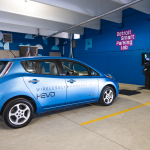
HEVO WIRELESS CHARGING STATION
The lab’s newest inhabitant, HEVO, (Hybrid and Electric Vehicle Optimization) is utilizing the space to test a cost-competitive, third-party certified, manufacturable, and highly efficient wireless EV charging product suite.
With a robust pipeline in place, fostered by the States grant program, the future of this innovation will certainly be interesting.
In closing, Mull, with all parties in agreement, says “What’s most exciting is that the very concept of the lab – its existence – triggers unbridled inspiration, and we can’t wait to see what great minds create here.”
As always, be sure to subscribe to our newsletter for regular updates on all things Detroit and more.


